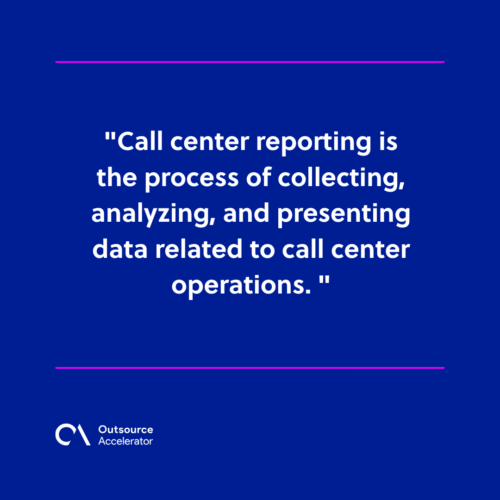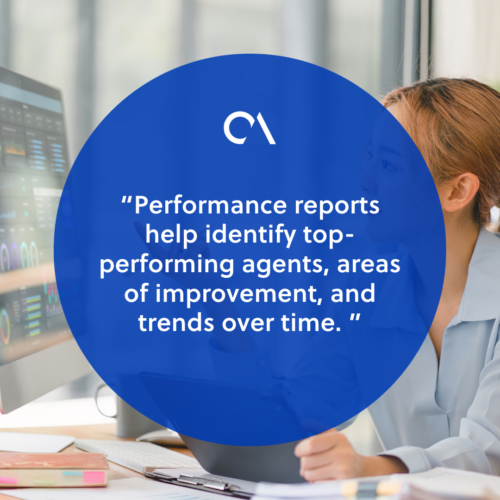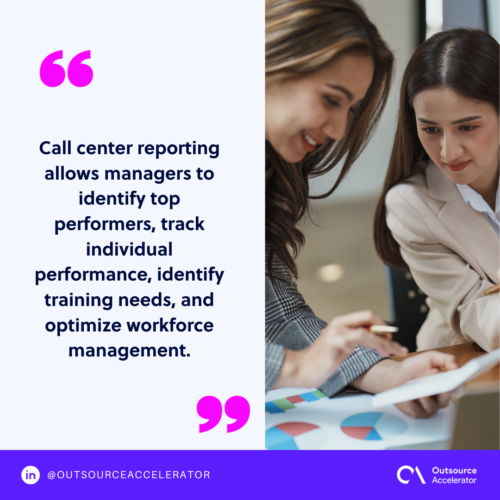Call center reporting: What it is and how it works

Call center teams must provide the best service possible for their customers. How this success is measured should be taken into consideration.
These measures are better interpreted through call center reporting.
Call center reporting is a way to convert data from call center efforts into summaries and insights. It categorizes information into performance indicators and visualizes them into graphs to better understand their outlook.
This article will delve more into call center reporting, its benefits, and best practices.
What is call center reporting?
Call center reporting is the process of collecting, analyzing, and presenting data related to call center operations. It involves tracking, measuring, and evaluating various metrics and key performance indicators (KPIs) to gain insight into call center performance.
These insights help businesses understand their customers better, identify areas for improvement, and make informed decisions.
Call center reporting is more than just generating graphs and charts. At its core, it is about taking data and transforming it into valuable insights that can drive business growth and improve customer experience.
When done right, this can be a powerful tool for enhancing the entire customer service journey.

How does call center reporting work?
Call center reporting works by capturing and analyzing data from various sources within the call center ecosystem. This data can include:
- Call logs
- Agent performance metrics
- Customer feedback
- Customer interaction records
Once the data is collected, it is processed and transformed into meaningful reports and visualizations. These reports provide actionable insights into key areas such as:
- Call volume
- Wait times
- Average handling time
- Agent performance
In practice, reporting for this effort requires the use of call center analytics tools and a team of experts who can manage, analyze, and interpret the data.
Types of call center reports
There are different call center reports, each with its focus and objective. Below are the three common types of these reports.
Performance reports
Performance reports focus on the call center’s and its agents’ overall performance. They can be used to measure agent efficiency, productivity, and quality of service.
These reports provide information on key metrics such as average call handling time, resolution rate, call abandonment rate, and customer satisfaction scores.
Performance reports help identify top-performing agents, areas of improvement, and trends over time. They also provide insights into how well agents meet service level agreements (SLAs) and other performance targets.

Operational reports
Operational reports give managers a deep insight into specific aspects of call center operations. They can include reports on call volume trends, call routing patterns, schedule adherence, and queue statistics.
Operational reports can provide valuable insights into how well the call center is run. They identify inefficiencies in processes, systems, and workflows that may impact agent performance and customer experience.
Customer experience reports
Customer experience reports focus on the satisfaction and experience of customers interacting with the call center. These reports measure first call resolution, average hold time, customer sentiment, and customer feedback.
Customer experience reports help firms understand customer needs, pain points, and opportunities for improvement.
Benefits of call center reporting
Call center reporting provides several advantages to businesses, including:
1. Data-driven decision making
Call center reporting enables firms to see the big picture, identify trends, and evaluate performance over time.
By tracking and analyzing key performance metrics, teams can identify trends, patterns, and areas for improvement. It includes deciding which teams should undergo coaching and training efforts as needed.
2. Improved customer experience
A great customer experience is critical to business success.
Through call center reporting, teams can optimize call routing and reduce wait times, leading to happier customers and increased satisfaction.
By using call center reporting to monitor customer interaction and improve agent performance, businesses can deliver exceptional customer service and win customer loyalty.
3. Enhanced agent performance
Call center reporting allows managers to identify top performers, track individual performance, identify training needs, and optimize workforce management.
By analyzing agent metrics, managers can identify inefficiencies and provide agents with the training and resources they need to perform at their best. This leads to improved agent efficiency, motivation, and overall performance.

4. Cost reduction
By analyzing call center data, businesses can implement cost-saving strategies.
Effective call center reporting can help identify opportunities to optimize processes and automate tasks. Implementing these strategies saves time and money for the organization while improving the overall customer experience.
5. Continuous improvement
Regular monitoring and analysis of call center metrics can help improve operations and processes continuously.
Call center reporting provides continuous performance feedback, helping managers make data-driven decisions that result in continuous improvement. Firms can refine their strategies, implement best practices, and stay ahead of competitors.
Call center reporting best practices
Call center reporting is crucial in optimizing operations and driving business growth. Through the power of data, businesses can make informed decisions and stay ahead in the competitive customer service landscape.
Implementing best practices ensures that call center reporting becomes a valuable tool for continuous improvement and success.
Here are some best practices for implementing call center reporting:
Define relevant metrics. Identify the key metrics that align with your business goals and objectives. Focus on measuring metrics that directly impact customer experience and agent performance.
Review and analyze data. Continuously monitor and analyze call center data. Visualization tools present data in an easily understandable format, enabling stakeholders to make informed decisions.
Foster a data-driven culture. Encourage a culture of data-driven decision-making within your organization. Share call center reports and insights with relevant stakeholders and empower them to use data for decision-making.
Embrace technology. Leverage advanced call center software and analytics tools to automate data collection and reporting processes. This streamlines operations and allows for real-time insights.







 Independent
Independent




